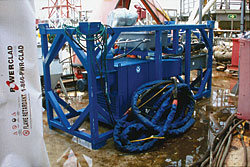
Rig operators face a daunting challenge repairing or applying protective coatings regardless of the weather. "There is a short season, usually between mid-May and mid-October, which essentially is the only time we can conduct exterior blasting and coating work," said Cec Cooper, senior project manager with Crosbie Salamis Ltd. in Newfoundland.
The company provides technical and managerial maintenance services to the energy, marine, and construction industries in Canada. As part of its services, the firm does surface preparation and applies protective coatings on offshore facilities.
To accomplish such work, typically contractors first construct a tarpaulin-enclosed habitat covering about 1,500 cubic feet of work area. Dehumidifiers are employed to reduce moisture inside the covering, improving conditions to hold the blast and apply and cure the coatings.

A Better Environment
Cooper knew that warming the air inside the envelope would produce an even better environment. Unfortunately, the only units certified by Canada until now have been cooling-based dehumidifiers, which cool the air to condense moisture and then draw it away.When Cooper sought to accomplish both drying and warming, he knew that desiccant dehumidifiers could accomplish those goals.
Unlike the cooling-based units, desiccant dehumidifiers attract moisture molecules directly from the air and release them into an exhaust airstream. Desiccants can attract and hold from 10 percent to more than 10,000 percent of their dry weight in water vapor. The units warm the air as they reduce vapor pressure. Desiccants do not freeze when operated at low temperatures such as those experienced on the North Atlantic platforms.
All equipment used on offshore facilities in Canadian waters must be approved for "hazardous location" service according to the Canadian Electrical Code.
Cooper contacted the Moisture Control Services (MCS) division of Munters Corp., a worldwide provider of humidity control products and services, with the idea to develop a new unit that could meet the code. MCS specializes in building rental systems that control humidity in a variety of work environments. Crosbie Salamis previously had used MCS dehumidification systems for marine and shipping applications such as blasting and coating ship hulls.

Up To The Challenge
The unit needed certain specifications such as size and power requirements that would be unique when dealing with offshore rigs. It also would have to be certified as explosion-proof by the Canadian Standards Association (CSA)."To gain certification, the unit needed to be intrinsically safe," said Fabio Bernardo, district manager with Munters MCS in Montreal. "The key rule of the code is ‘explosion-proof,' which means a unit will not spark or arc, nor will it explode if subjected to external forces such as a fire."
To accomplish the assignment, Bernardo worked closely with the CSA on every step of development, engineering, and assembly to ensure all code requirements were met. A basic unit was created on paper and subjected to a CSA review and subsequent CSA recommendations.
The process took nearly two years to gain certification and deliver the unit to Crosbie Salamis. As a result, the innovative unit, designated M-EXP-5, became the first explosion-proof desiccant dehumidification unit certified by Canada for offshore use.
"The M-EXP-5 is essentially a hybrid from our existing HC dehumidifier platform that incorporates both CSA recommendations and customers' specifications in a unique package," said Bernardo.
The M-EXP-5 was delivered to Crosbie Salamis in October 2004. Crosbie Salamis was starting to repair the interior of a stainless steel fresh water holding tank on
a platform off the coast of Newfoundland. Cooper decided to use the unit to control the environment inside the tank, which is 6 feet in diameter and 12 feet high.
"Despite the fact that crews operated in ankle-deep water in the area surrounding the tank, we maintained constant relative humidity of 25 percent, with ambient temperature of 5 degrees C (41 degrees F) during the five-day project," Cooper said. "We also held a temperature of up to 28 degrees C (77 degrees F) on the surface to be coated by directing the warm airflow from the ducts directly onto the metal surface."
"Depending on the amount of moisture to be removed and the conditions present, the number of hourly air changes to be effective can vary greatly from job to job," Bernardo said. "Before beginning any project, we calculate the rates based on the contractor's specifications for each application."
Bernardo said another company began using the new certified units in early 2005 for exterior blasting and coating work on a rig in Nova Scotia.
For more information, visit www.munters.com.
Publication date: 06/27/2005

Report Abusive Comment